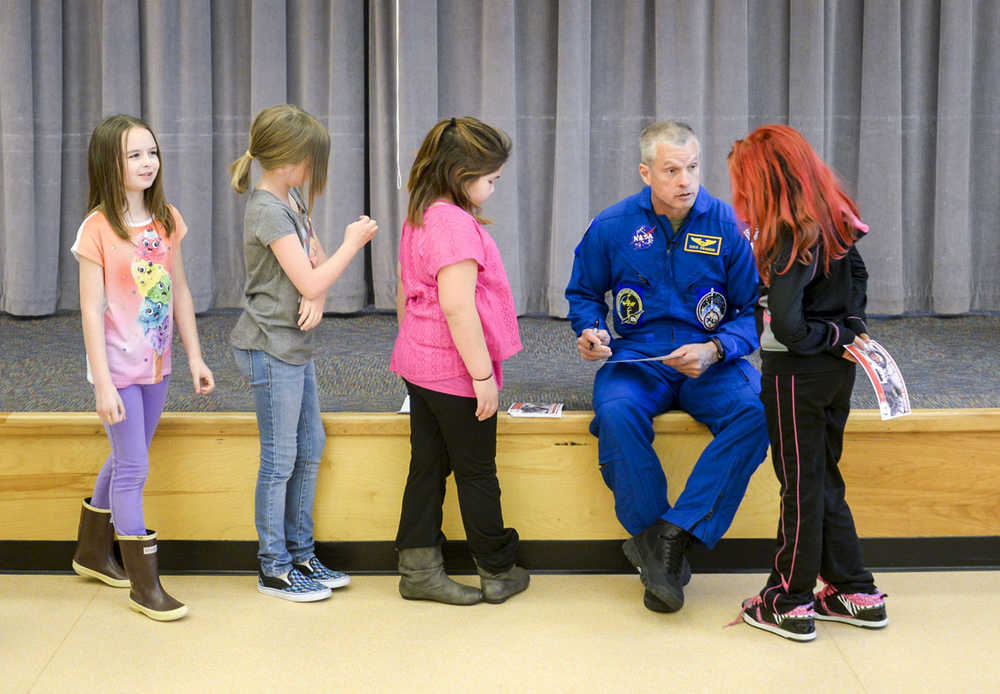KETCHIKAN (AP) — It takes approximately eight minutes and 52 seconds for a shuttle carrying astronauts to the International Space Station to get to space, according to astronaut Steve Swanson, who visited Ketchikan earlier this month. A shuttle reaches speeds of 5 miles a second in breaching the earth’s atmosphere.
Fawn Mountain Elementary School’s students moved almost as quickly to line up in front of Swanson when he asked whether anybody wanted an autograph during his visit to the school.
Swanson visited the school as part of American300’s tour of Alaska. American300 is an all-volunteer, nonprofit organization that brings interesting and relevant guests to U.S. service stations around the world to “put a face on resiliency,” said Robi Powers, the organization’s founder.
“Our program’s based on presenting — to the community and to our services members — valued guests, folks that have been there and done that before in some shape, form or another,” Powers said.
Though American300 has visited Ketchikan four times with other guests over the past year, Swanson was the first American300 guest to visit local schools, said Jeremy DeMello, Coast Guard Base Ketchikan’s command senior chief. Swanson and Powers also visited Schoenbar Middle School.
“The first time (Powers and an American300 guest) came up, it was strictly just the Coast Guard, and now we’re reaching out to the communities,” DeMello said. “We went to the American Legion, we’re meeting with the Rotary (Club, and) we’re going to the schools.”
Swanson showed about 25 minutes of video footage to Fawn Mountain students of his six-month residency in the International Space Center. He told the students about everyday life in space, explaining how gravity affects the human body and how to make space food. Swanson also showed footage of the experiments he and his two crewmates conducted, including one experiment replayed at various speeds and angles where a bald crewmember headbutted a floating ball of water.
Swanson took questions from the students, who wondered if he had to wear a space diaper (only when in the space suit), and if they could see the stars better (yes, but they don’t twinkle). After a couple of group photos, the kids lined up to get Swanson’s autograph on the NASA coloring pages their teachers gave them.
While waiting in line for Swanson’s autograph, students Clara Odden and Hannah Nenni said they had fun and learned a lot watching the presentation.
“I want to smash my face into a bubble,” Nenni said.
“Me too!” Odden added.
After Swanson’s presentation, Powers told the audience to dream big and later said he hoped that meeting Swanson will enable kids to pursue their bubble-smashing and many other dreams.
“I met an Olympian as a young kid, and it lit a fire in me,” Powers, who is an Olympian himself, said. “I think it’s hugely important (for kids to have and meet heroes), and NASA thinks it’s important, so we’re not alone in wanting to see astronaut Swanson in the school system. … Putting the example, the living breathing example of what is possible in life into the hearts and minds of our future leaders, of our future amazing generation, you know, you have to do it.”
Powers and Swanson also visited the Coast Guard Base Ketchikan during their visit this past week, and Swanson went with local crews doing search and rescue training on a 45-foot fast response boat, Powers said.
“One of the highlights about coming to Alaska especially has been being able to show (American300 guests) just what the Coast Guard does 24-7, and — it’s a pretty strong limb I’m going out on — in some of the most austere weather on planet Earth,” Powers said. “This is not a friendly mother nature up here at times, and yet the Coasties are out there having to ensure that these commercial fishermen and recreationists are out there able to do it safely and securely.
“Alaska is remote, and from the Department of Defense standpoint, when we talk about the morale programming, Alaska doesn’t get a ton of it due to its remote nature,” Powers added. “I have now visited 16 bases in Alaska in the last year, and we see it as a need. We feel that the troops here in Alaska are every bit as deserving of our resiliency message as those are in Afghanistan and Iraq and around the world that we visit.”
Powers and Swanson continued on to U.S. Air Force, Army and Coast Guard bases in Anchorage, Clear, Fairbanks, Greely, Homer and Wainwright over the next week to finish the Alaska resiliency tour.
Powers said he’ll be back, quarterly in fact, and that in August, Ketchikan can add either a Medal of Honor recipient or a wounded warrior “who’s an amazing singer” to the list of resilient guests, which already includes Swanson, a professional rodeo champion, the first amputee to summit Mount Everest and a retired general who spent six years as a prisoner of war. And that’s a list the Powers said will keep growing.
“We’ll continue to visit for years to come,” he said.
Information from: Ketchikan (Alaska) Daily News, http://www.ketchikandailynews.com

